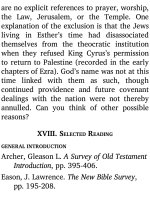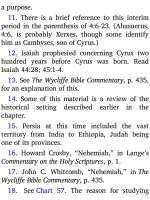Jensens survey of the old testament adam 516
Bạn đang xem bản rút gọn của tài liệu. Xem và tải ngay bản đầy đủ của tài liệu tại đây (116.08 KB, 4 trang )
was a very prosperous city.
6 . Religion. Idolatry was the common
religion of most of the Greeks. Nearby
Mount Olympus, viewed daily by the people,
stood as a symbol of the gods. In ancient
times, it was at the summit of Mount
Olympus that Zeus was believed to gather
together all the gods of Greece for a council.
The Jewish community of Thessalonica
was either large or in uential, or both, as
seen from the action of Acts 17:5. The Acts
account records that Paul’s rst evangelistic
preaching was done in the city’s synagogue
(Acts 17:1-4).
There was also a large Roman segment of
the populace, with a strong nationalistic
devotion to the emperor Caesar (cf. Acts
17:7).
B. THE FIRST CHRISTIAN CHURCH OF
THESSALONICA
1
. Paul’s
evangelistic
campaign.
Thessalonica was the second major city
visited by Paul for an evangelistic ministry
on his second missionary journey (Philippi
was the rst). Read Acts 17:1-10 for Luke’s
brief account of this ministry. Observe the
following:
a. Upon arriving at the city, Paul rst
shared the gospel with the Jews in the
synagogue. That was his customary
procedure. How long did that mission
continue?
b. Paul based his ministry on the
Scriptures. What does the phrase “reasoned
with them” (Acts 17:2) reveal about Paul’s
method of communicating the gospel to the
Thessalonians?
c. Paul tried to establish three basic
truths, in this order:
(1) Christ (the promised Messiah,
Redeemer) had to suffer and die.
(2) Christ had to rise from the dead.
(3) The Jesus whom he preached was
this Christ.
If you had only the Old
Testament today, as Paul
had then, how would you
support each of the above
three truths, from those
Scriptures? For a starting
point, see Isaiah 53.
d. Immediate results of Paul’s ministry
(Acts 17:4-5):
(1) Some Jews were converted.
(2) A great multitude of devout Greeks
believed.
(3) A substantial number of leading
women believed.
(4) The Jews who rejected Paul’s
message stirred up a riot.
(5) Paul was forced to leave the city.
e. Paul’s later contacts
Thessalonian Christians:
with
(1) Twice Paul was hindered from
returning to Thessalonica soon after
his first visit (1 Thess. 2:17-18).
(2) He sent Timothy to minister in his
place (1 Thess. 3:1-2).
(3) He wrote the two epistles.
the









